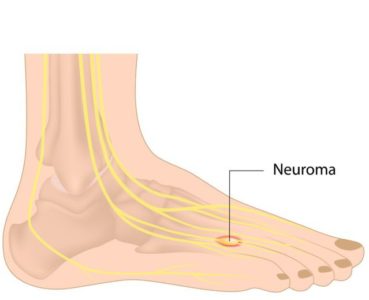 When people think of pinched nerves, they often often imagine the problem arising somewhere in your back, but that’s not always the case. When pinched nerves or nerve tumors develop in the feet, this is known as a neuroma. Today, we take a closer look at why they develop, what symptoms they cause, and how the condition is treated and prevented.
When people think of pinched nerves, they often often imagine the problem arising somewhere in your back, but that’s not always the case. When pinched nerves or nerve tumors develop in the feet, this is known as a neuroma. Today, we take a closer look at why they develop, what symptoms they cause, and how the condition is treated and prevented.
Neuroma Development and Symptoms
A neuroma is categorized by a benign growth of the nerve tissue in the toe area. A neuroma will most commonly develop between the third and fourth toes, but they can develop in other areas as well. Symptoms include pain, a burning sensation, swelling, and tingling or numbness throughout the foot region. The most common symptom is pain while walking, and many describe the problem as feeling like you have a pebble stuck under the toe area in your shoe with each step.
There are no direct causes of neuroma development, but medical experts suggest that there are four factors that increase a person’s likelihood of developing a neuroma. Those four factors are:
- Trauma to the foot or toes can result in nerve damage or inflammation.
- Improper footwear that pushes the toes together can stress and strain nerves, leading to neuroma development.
- Excess stress during a short period of time or over decades of physical labor can lead to neuroma development or aggravation.
- Biomechanical deformities. Foot deformities like a high-arch or a flat foot can lead to instability in the toe joints, leading to neuroma development.
Neuroma Treatment and Prevention
Prevention is always preferred to treatment, so we’ll start with some tips for preventing neuromas from developing in the first place.
- Wear shoes that provide plenty of room for your toes.
- Find a shoe with ample support for any pre-existing foot conditions, like a high-arch or for flat feet. Custom orthotics can always help ensure pressure is evenly distributed throughout the foot.
- Avoid wearing shoes with a heel over two inches tall. If you have to wear high heels, try to limit the amount of time you spend in them.
Treatment of the condition begins with an accurate diagnosis. Your doctor will begin by listening to your description of symptoms and then conduct a physical exam. If the doctor believes you have a neuroma in an early stage, you’ll likely be told to follow some of the above prevention tips, and you’ll be asked to only where shoes with a wide toe box. Anti-inflammatory medications and special padding may also be used to prevent the onset of inflammation and to take pressure off the toe.
However, if treatment fails or the neuroma is severe in nature, surgery may be your best option. The procedure involves creating a small opening in the foot and removing the inflamed or enlarged nerve. The procedure can generally be performed on an outpatient basis, and full recovery takes just a couple of weeks. Your foot surgeon can walk you through the specifics of the operation, but it is generally a very straight forward procedure with highly successful results. Post-op pain is generally managed with medications and a patient-specific plan designed by the surgical team. For more information on the procedure, or to discuss your foot pain with a foot specialist, click here.